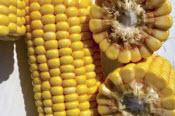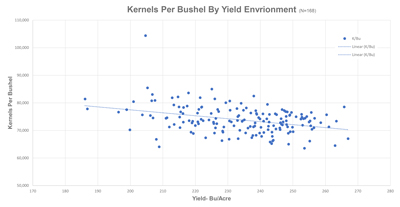
Recording these finer details will allow you to manage for larger yield increases.
By Paul Hermans
The 2023 corn growing season across most of Eastern Canada will go down in the history books as being one of the highest yields on record.
Looking back at the 2023 growing season may leave a few agronomists scratching their heads as to why the yields were so high.
In Eastern Ontario, I looked at corn plot averages in 2023 and compared them to corn plot averages in 2022. Most of our corn plots are grown in the same area, with the same growers and hybrids year over year, giving us a good perspective on yield trends. In 2023, corn plot averages were 231.9 bushels, and in 2022, they were 215 bushels. That is an astonishing extra 16.9 bushel increase in 2023.
So where did all this extra yield come from?
Let us do a deeper dive into where grain corn yield comes from.
Simply put, Yield = G * E * M (or Yield = Genetics and Environment and Management).
If we break down the genetic component of a hybrid, corn has four key growth stages in its life.
The first key ones are germination and stand establishment. We always talk about corn populations, but that comes down to plant-to-plant uniformity, and even in emergence, that relates to final yield.
Having uniform cob size with optimum plant populations for a given management zone is critical. In 2023, plant stands were consistently uniform thanks to excellent spring planting conditions with timely rains.
The next critical phase is around V6, when the corn plant determines the number of kernel rows around a plant. Looking back at the first 45 days after planting, stresses were minimal. In some cases, the first part of the season was dry, but being dry early is better than later in the growing season.
The next phase, pollination, occurred when we finally got ample rains and moderate temperatures across most of the area. This allowed for ideal kernel set and minimal kernel abortion.
The last 30 days – better known as the “kernel weight/seed depth” phase – had stress-free conditions and avoided any killing premature frosts.
Kernel depth and kernel weights in corn were not reduced in 2023 with optimal growing conditions. Corn plants kept “chugging along.”
To obtain yield calculations prior to harvest, we always talk about kernel rows around a cob, kernels per row up a cob and multiply that by the number of harvestable ears per acre. We then divide that by estimated kernels per bushel to get yield in bushels per acre. This where we gained a lot of extra yield this year. Normally we would use a factor of 85,000 or 90,000 kernels per bushel in the equation. In 2023 kernels per bushel were less than 80,000 in a lot of cases which contributed to higher yields on an acre basis.
I decided to take one plot and do some key yield estimates using traditional kernel-per-bushel numbers.
In one plot we had two hybrids weighed across the weigh-wagon scales two times. We did kernel estimates for each hybrid five times in two separate locations. I then calculated the kernels per bushel. Using the average number of kernels around, kernels up and down the cob, plus the harvestable ears, I calculated yield estimates based on traditional numbers and the calculated kernels per bushel.
Using the traditional kernels-per-bushels of 85,000 and 90,000, yield estimates were off significantly – in the 75 per cent range. Using the actual kernels-per-bushels, estimates were within 96 per cent.

Collaborating with fellow agronomist James D’Aoust, in the Toronto to Quebec border area, we looked at 168 samples of corn. The average calculated kernels per bushel was 73,872. Ranges by hybrid and growing environment were noted, from a low of 60,000 kernels per bushel to 90,000 kernels per bushel.
There was correlation between yield and kernels per bushel. The higher the yield, the lower the kernels per bushel. One secret to success for higher yields is getting lower kernels per bushel.

For future yield estimation, consider kernels-per-bushel estimates and kernels per acre, and determine these prior to harvest to get accurate estimates. This will allow for potential selling of additional yield, and maximizing on commodity markets should late-season price rallies occur.
Simple counting apps like “Count This” are great tools to make this task easy for your farm operation.
Doing some counts throughout the day from different fields will give you a sense on kernels per bushel, as you strive to maximize not only kernels per acre but kernel weights.
Kernel weight accounted for some of this yield increase for sure, but so did the environment. A lot of growers commented that their lower-yielding management zones had a higher percentage increase in yield compared to their consistently higher-yielding management zones.
Weather played a key factor in part of this, as water availability was a non-limiting factor in 2023.
The key take-home messages from this study include:
- Kernel weights matter. The larger the kernel, the more yield there is.
- How do we manage for higher kernel weights? By managing the environment and ensuring corn does not have a difficult day, any day. Fungicide, attention to nitrogen, and sound fertility programs add up. Managing for higher water availability in the soil rooting zone is key to ensure grain fill occurs without any stresses. Pay attention to populations in these different zones.
- To maximize yield, it is critical to have high kernel weights, and also the right number of kernels per acre.
At the end of the day, paying attention to recording these finer details for the next harvest season will allow you to manage for larger yield increases. BF



Post new comment